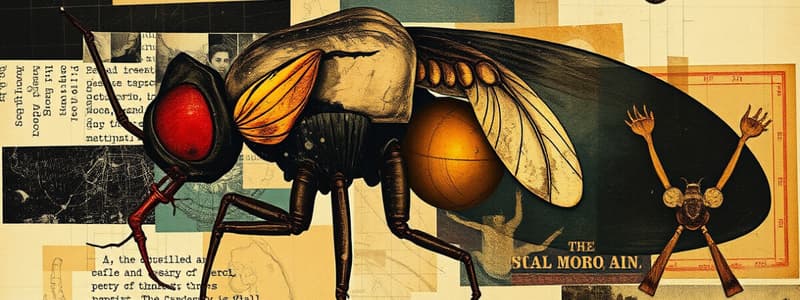Podcast
Questions and Answers
What is algor mortis?
What is algor mortis?
The cooling of the body after death.
What is autolysis?
What is autolysis?
The spontaneous breakdown of cells as they self-digest.
What is the cause of death?
What is the cause of death?
The immediate reason for a person's death.
What is death?
What is death?
What is decomposition?
What is decomposition?
What is forensic entomology?
What is forensic entomology?
What is an instar?
What is an instar?
What is a larva?
What is a larva?
What is livor mortis?
What is livor mortis?
What is the manner of death?
What is the manner of death?
What is the mechanism of death?
What is the mechanism of death?
What is a pupa?
What is a pupa?
What is rigor mortis?
What is rigor mortis?
What happens during livor mortis?
What happens during livor mortis?
When does blood start to pool in the body?
When does blood start to pool in the body?
When does discoloration from livor mortis become permanent?
When does discoloration from livor mortis become permanent?
How can lividity help crime investigators?
How can lividity help crime investigators?
Describe the cycle of rigor mortis.
Describe the cycle of rigor mortis.
Name factors that affect rigor mortis.
Name factors that affect rigor mortis.
How do you find the temperature of the corpse?
How do you find the temperature of the corpse?
How much body heat is lost every hour after death?
How much body heat is lost every hour after death?
Describe the digestive system.
Describe the digestive system.
What are accessory organs?
What are accessory organs?
What is the job of the liver?
What is the job of the liver?
What is the job of the gall bladder?
What is the job of the gall bladder?
What is the job of the pancreas?
What is the job of the pancreas?
How long does it take for the stomach to empty into the small intestine?
How long does it take for the stomach to empty into the small intestine?
How long does it take for a body to fully digest a meal and release it from the body?
How long does it take for a body to fully digest a meal and release it from the body?
If undigested food is present in the stomach at the time of death, how long has the body been dead?
If undigested food is present in the stomach at the time of death, how long has the body been dead?
If the stomach is empty but food is found in the small intestine, then how long has the body been dead?
If the stomach is empty but food is found in the small intestine, then how long has the body been dead?
If the small intestine is empty and water is found in the large intestine, then how long has the body been dead?
If the small intestine is empty and water is found in the large intestine, then how long has the body been dead?
Flashcards are hidden until you start studying
Study Notes
Forensic Terminology
- Algor mortis: Refers to the cooling of the body post-mortem.
- Autolysis: The process of self-digestion where cells break down spontaneously.
- Cause of death: The immediate medical reason for a death, such as heart attack or kidney failure.
- Death: Defined as the cessation of biological functions that sustain life.
- Decomposition: The breakdown of organic matter leading to its rotting.
- Forensic entomology: The study of insects to resolve legal questions, especially in forensic cases.
Insect Development Stages
- Instar: One of the three stages in insect larval development.
- Larva: The immature stage following egg hatching; examples include maggots.
- Pupa: The transformation stage where the larva encases itself and eventually becomes an adult.
Post-Mortem Processes
- Livor mortis: Blood pools in lower body regions post mortem, leading to a bluish tint on the skin.
- Manner of death: Categorized as natural, accidental, suicidal, or homicidal.
- Mechanism of death: Describes the specific physiological failure resulting in death.
- Rigor mortis: The stiffening of muscles after death, occurring in a specific cycle.
- Timeline for livor mortis: Blood pooling begins 2 hours after death and becomes permanent after 8 hours.
Rigor Mortis Cycle
- Begins 2 to 6 hours post-mortem; starts in the head and progresses downward.
- Peaks at around 12 hours when the entire body is rigid.
- Gradual relaxation occurs from approximately 15 to 36 hours after death, with stiffness dissipating.
Factors Influencing Rigor Mortis
- Ambient temperature, body weight, clothing, pre-existing health issues, activity level at death, and sunlight exposure.
Determining Body Temperature
- To assess a corpse's temperature, a thermometer is inserted into the liver, indicating body heat loss of 1-1.5 degrees Fahrenheit per hour after death.
Digestive System Overview
- Food digestion begins in the mouth with amylase, proceeds to the esophagus, stomach (where pepsin acts on proteins), small intestine (nutrient absorption), large intestine (water absorption), and concludes at the rectum.
Accessory Organs
- Liver: Produces bile necessary for digestion.
- Gall bladder: Stores bile for later use.
- Pancreas: Regulates blood glucose levels by releasing insulin.
Digestion Timelines
- Stomach empties into the small intestine in 4 to 6 hours.
- Complete digestion and waste release takes approximately 24 hours.
- Presence of undigested food in the stomach at death indicates a time frame of 0 to 2 hours.
- An empty stomach with food in the small intestine signifies a death time of 4 to 6 hours.
- An empty small intestine with water found in the large intestine suggests over 12 hours since death.
Studying That Suits You
Use AI to generate personalized quizzes and flashcards to suit your learning preferences.




